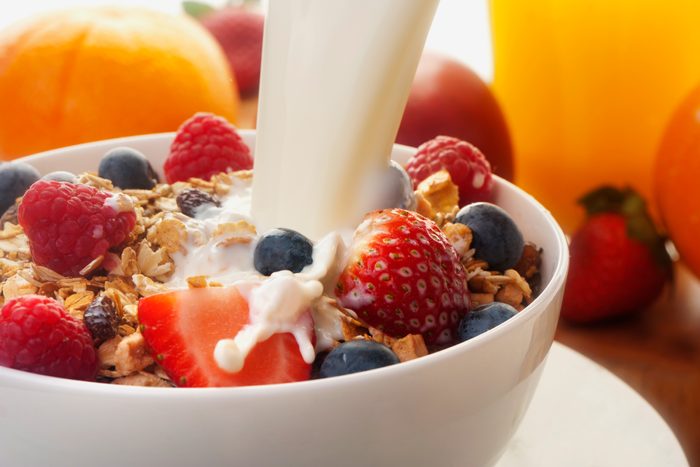Here’s How Much Fat Is in Whole Milk, With a Nutrition Expert’s Wisdom
Updated: Sep. 08, 2023

Many people have come to perceive dairy milk—especially whole milk—to be unhealthy. But is it? A dietitian shares the conditions that allow whole milk to make up part of a healthy diet.
What do you dip your Girl Scout thin mints in? What do you splash in your coffee? What do you pour over your cereal? (Or, what do you pour your cereal into, depending on where you land in the “Which comes first, milk or cereal” debate that had social media in a frenzy.)
The answer, in most cases, is milk. It makes sense: This dairy delight has been considered an American dietary staple for as long as cows have been domesticated. But that may not be as true today.
Between 1975 and 2022, the average American went from drinking 1.5 cups of milk per day to a little over half a cup per day. The USDA recommends adults get two to five servings of dairy per day…so why are Americans drinking so much less milk than they used to?
One answer is that many people perceive milk—especially whole milk—to be unhealthy. But is it? We asked a registered dietitian, Pam Schoenfeld, to spill the milk…the tea…er, the secrets of healthy dairy intake these days—especially if you’re concerned about your fat consumption.
Here’s How Much Fat You Really Need in a Day, with a Nutrition Expert’s Wisdom
What is whole milk?
Before you can decide if it would be healthy for you to include whole milk in your diet, you need to know what it is. “Whole” milk, or full-fat milk, isn’t made wholly of fat.
Rather, the name “whole milk” simply means that it is the closest to how it comes out of the whole out of the cow, containing all the naturally occurring fat in milk. Reduced-fat and skim milk, on the other hand, are processed to remove some of the fat before being bottled and sold.
I Drank Pea Milk Every Day for a Week—Here’s What Happened
What percent fat is whole milk?
Whole milk normally contains around 3.25% milk fat by weight. So for every 100 grams of whole milk, 3.25 grams would be fat. Reduced-fat milk contains 2% fat, and skim milk has 0% fat (having had the fat “skimmed” off). You can sense the difference: Whole milk tastes creamier and richer compared to other milks.
The Best Health & Wellness Books for Your 2023 Reading List
Is whole milk healthy?
“There is a misguided belief that foods with fat are ‘fattening’ and therefore should be avoided, but fats are satiating and important for absorbing the nutrients from our food,” Schoenfeld says. She adds that whole milk also contains protein and provides essential nutrients, including fat-soluble vitamins like vitamin A and vitamin D.
Whole milk specifically has been found in research to have multiple health benefits. A 2021 meta-analysis (a study that reviews already-existing studies on the same topic) found that adults who drank one to two servings of milk per day benefited from a lower risk of cardiovascular disease, stroke, hypertension, colorectal cancer, type 2 diabetes, metabolic syndrome, obesity, Alzheimer’s disease, and osteoporosis.
Those benefits translate to kids as well. “We’ve found that children who ate foods containing milk fat have a reduced likelihood of asthma, allergies, and a lower risk for obesity, to name a few benefits,” she says.
The key is balance, she says. The fat in whole milk is saturated fat, and too much can increase your risk of disease.
“It’s not necessary to drink milk—but sources of natural fats, including whole milk, can be a part of a healthy diet,” she says. “If you enjoy it, it’s fine to have a small glass or two.”
If milk doesn’t agree with your tummy, plant-based milks can offer tasty and nutritious alternatives.



















